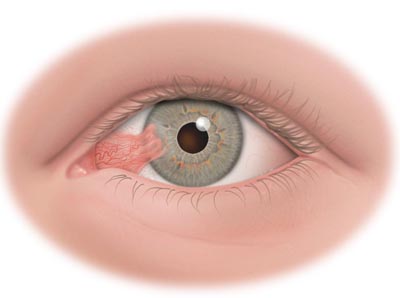WHAT IS A PTERYGIUM?
A pterygium is a benign growth of conjunctiva (the membranous covering of the eye). It is thought to be due to UV light, wind, and dust exposure. It is most common in people who have grown up in locations near the equator.
WHAT ARE THE SIGNS AND SYMPTOMS OF A PTERYGIUM?
The most common signs and symptoms are redness, irritation but a pterygium may also cause decreased vision.
Most pterygia do not need to be treated and prevention of further progression with the use of sunglasses is recommended. Indications for removal include frequent or persistent irritation, blurred vision, or if the pterygium is encroaching on the pupil.
WHAT IS THE TREATMENT FOR A PTERYGIUM?
The treatment, if required, is surgical removal. This is done as an outpatient with the patient awake. Eye drops are used to freeze the eye. Some freezing is also injected beneath the pterygium. However, minimal discomfort is experienced. The pterygium is excised from the cornea. Finally a conjunctival graft is taken from the top part of the eye (beneath the eyelid) and is placed in the area where the pterygium was previously. This can be placed with with sutures or with a tissue glue called Tisseel. Both are successful but the advantages of Tisseel include quicker surgery, significantly less postoperative discomfort, and much quicker healing/resolution of redness. The glue is not provided by the hospital and costs $300.00 per eye, which would need to be paid at least one (1) week prior to the procedure.
WHAT ARE THE RISKS OF PTERYGIUM EXCISION?
Pterygium excision is very safe. The main risk is approximately a 5-10% of recurrence of the pterygium. There is about a 10-15% chance that the area will remain red. Exceptionally rare risks include double vision and injury to the globe/eyeball itself.
WHAT CAN I EXPECT AFTER PTERYGIUM EXCISION?
The first 24-36 hours are quite painful whether sutures or Tisseel is used. Tylenol and Advil are generally recommended in combination. Otherwise, the discomfort with glue generally only lasts a few days whereas with sutures there is generally irritation for about 1 month. A contact lens is usually placed after surgery to help with pain and healing of the surface of the cornea. This will be removed at the first postoperative visit 3-4 days after surgery. Eye drops will be required for about 1 month after surgery.

